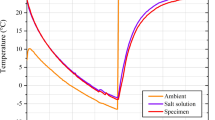Abstract
The objective of the present work was to systematically investigate the issue of minimum cement content requirements, by studying the behavior of concretes with different water to cement ratios ( w/c) in the range of 0.45–0.70, in which the cement content was varied, by controlling the water content, using water reducing admixtures. The effect of cement content was noted to be different for various properties: strength was a function of w/c and independent of cement content; total water absorption was proportional to the paste content at a given w/c, while capillary absorption and chloride ingress reduced with a reduction in the cement content for a given w/c, to an extent which was much greater than the reduction in total porosity. Carbonation and shrinkage were largely independent of cement content for a given w/c. The trends observed were discussed in terms of the effect of paste content on concrete properties, and the influence of admixtures on the paste properties. These results suggest that requirements for minimum cement content in standards should be revisited.














Similar content being viewed by others
References
Katz A, Baum H (2006) Effect of high level of fines content on concrete properties. ACI Mater J 103(6):474–482
Bentur A, Diamond S, Berke NS (1997) Steel corrosion in concrete. E&FN SPON, UK
Buenfeld NR, Okundi E (1998) Effect of cement content on transport in concrete. Mag Concr Res 50(4):339–351
Loo YH, Chin MS, Tam CT, Ong CGA (1994) A carbonation prediction model for accelerated carbonation testing of concrete. Mag Concr Res 46(168):191–200
Monteiro PJM, Helene PRL (1994) Designing concrete mixtures for desired mechanical properties and durability. In: Proceedings, concrete technology, past present and future, ACI proceedings SP-144, pp 191–200
Dhir RK, McCarthy MJ, Zhou S, Tittle PAJ (2003) Role of cement content in specifications for concrete durability: cement type influences. Struct Build 157(SB2):113–127. doi:10.1680/stbu.157.2.113.36479
Wasserman R, Bentur A (2006) Effect of concrete composition on durability in natural acidic environment. Adv Cement Res 18(4):135–143. doi:10.1680/adcr.2006.18.4.135
Wasserman R, Bentur A, Katz A (2007) Re-evaluation of the requirements in standards for minimum cement content for durability performance. Research Report 2006640, National Building Research Institute, Technion, Haifa (in Hebrew)
EN 772-11 (2004–2006) Methods of test for masonry units—Part 11: Determination of water absorption of aggregate concrete, autoclaved aerated concrete, manufactured stone and natural stone masonry units due to capillary action and the initial rate of water absorption of clay masonry units (includes amendment A1:2004)
Thomas MDA, Bentz EC (2000) Computer program for predicting service life and life-cycle costs of reinforced concrete exposed to chlorides, University of Toronto. Life 365. http://www.nrmca.org/research/Life365.asp. Accessed 9 Oct 2008
Berke NS, Hicks MC (1992) The life cycle of reinforced concrete decks and marine piles using laboratory diffusion and corrosion data. In: Chaker V (ed) Corrosion forma and control for infrastructure. ASTM STP 1137, American Society for Testing and Materials, Philadelphia, pp 207–231
ACI 244R-01 (2001) Control of cracking in concrete structures. American Concrete Institute, Farmington Hills
Acknowledgment
The support of the Ministry for Construction and Housing is gratefully appreciated.
Author information
Authors and Affiliations
Corresponding author
Rights and permissions
About this article
Cite this article
Wassermann, R., Katz, A. & Bentur, A. Minimum cement content requirements: a must or a myth?. Mater Struct 42, 973–982 (2009). https://doi.org/10.1617/s11527-008-9436-0
Received:
Accepted:
Published:
Issue Date:
DOI: https://doi.org/10.1617/s11527-008-9436-0




